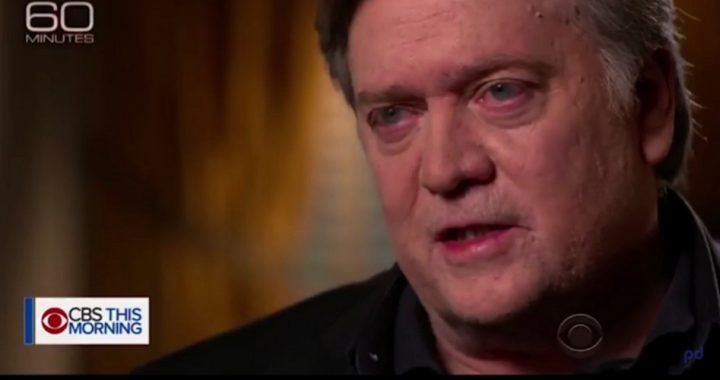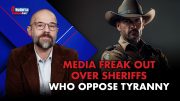
“A picture is worth a thousand words.” This principle was illustrated well in the first televised presidential debate — the 1960 affair with John F. Kennedy and Richard Nixon — after which people who’d listened to the event on radio thought Nixon won but those who’d actually watched it thought Kennedy won. After all, Nixon, with his five o’clock shadow and nervous glances, couldn’t match the telegenic JFK. This image lesson hasn’t been lost on the media, and now a professional photographer has accused CBS of “Nixonizing” Steve Bannon in a TV appearance the former White House advisor made this past Sunday.
In a short YouTube video, photographer Peter Duke (I love his name, but, no, no relation) explains how CBS used “color correction and grading” to make Bannon appear as a bleary-eyed drunk or drug user in his recent 60 Minutes interview with Charlie Rose. As the Gateway Pundit writes:
In the video, Duke explains how CBS color adjusted Bannon’s shots to make his eyes and lips red by increasing the level of saturation. This results in curtains that are a brighter orange behind Bannon than they are in Charlie Rose’s shot. Rose’s shot was made “cooler,” to make the host’s make-up more subtle.
Duke then adjusted the interview’s lighting, removing Bannon’s redness and Rose’s “coolness.”
The result is a natural looking Bannon.
It should be emphasized that the curtains behind the two men are the same in reality — but not on CBS’ unreality television. Moreover, while a person could have bloodshot eyes for many reasons, much of Bannon’s lower lip is such a deep shade of red that it appears as if he’s wearing lipstick; it doesn’t look natural.
Duke, mind you, speaks from great experience, having “photographed Milo Yiannopoulos, Scott Adams and James O’Keefe,” Gateway Pundit points out. Even more significantly, Duke has also met Bannon and states, “I know what he looks like. He’s Irish and he does kinda have paper skin. But, he doesn’t have pronounced red circles around his eyes. That’s not who he is in real life.”
As Duke puts it under his YouTube video (below), “It seems like 60 minutes would like you to listen less and look more at Steve Bannon. By subtly tweaking the color of the video, they make him look like a bleary-eyed drunk. I show you how they did it.”
What this story illustrates is that media organs today aren’t news purveyors but propaganda outlets carrying on the legacy of Josef Goebbels and Leni Riefenstahl (Hitler’s propagandists). And CBS’ actions aren’t unusual. As pundit Ann Coulter pointed out in a tweet: “GREAT VIDEO. Networks do this a lot. That’s why conservatives seem to look so much better on Fox News.”
The media certainly do this a lot. I remember years ago when a magazine ran an article on radio host Rush Limbaugh and used a picture of him with a fearsome grimace on his face. The truth?
He bore such a look because, at the moment that shot was taken, he was adjusting his tie.
Then, photographer Jay Caruso referenced three egregious examples of media photo bias against conservatives and contrasted this treatment with that received by the Obamas. Writing at National Review in March, he pointed out:
• A 2017 New York magazine profile piece on Donald Trump counselor Kellyanne Conway used photos designed to make her look as old and unattractive as possible. As Caruso put it, he was “taken aback.” “I’ve been a photographer for over 20 years,” he continued, “and I’ve done editorial and corporate headshots before. What I saw in New York magazine is something I would never present to a client.”
• A 2011 Newsweek profile of ex-Minnesota representative Michele Bachmann used a picture in which she appeared to have “crazy eyes” and that had embarrassingly poor lighting. “It’s as if the staff at Newsweek went through every image they were given and picked the worst one to use,” Caruso opined.
• In 2007, Time put on its cover a picture of GOP presidential nominee Mitt Romney that had flat lighting and made him look much older than he was.
Contrast this with a cover picture Time used of Barack Obama (the examples are available at National Review). As Caruso informs, “It is extremely well lit, giving the image a mysterious vibe while at the same time making Obama look like a striking figure.”
Caruso also mentioned that if “there were a picture of Michelle Obama that looked anything like the image of Kellyanne Conway or Michele Bachmann, people would lose their minds. If you go here, you can see images of Michelle Obama on covers of everything from Time to Vogue, looking terrific in every image.”
Note that these magazines’ photojournalists are professionals who cross every t and dot every i. Nothing is left to chance. This bias is conscious and calculated.
I asked in 2011 when the last time was that a bald, ugly, old-looking, or overweight person, or one with glasses, was elected president? The answer, as I wrote, is that “the last time Americans elected a bald president was 1956, when Dwight Eisenhower defeated similarly hair follicle-deprived Adlai Stevenson. Not coincidentally, this was just prior to the full flowering of the television age.”
Image may not be everything today — but it’s close.
And given that this image-bending bias is a continual feature in reportage, we should wonder: Nixon might have very well lost the razor-close 1960 election because of his televised debate. How many elections are swayed by photojournalism propaganda today?
Image: Screenshot from youtube video by Peter Duke



